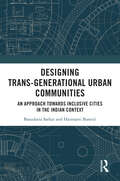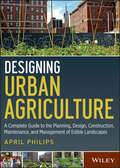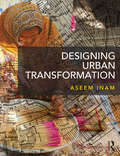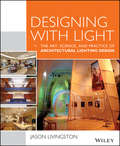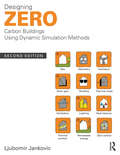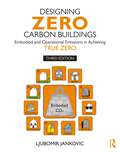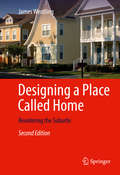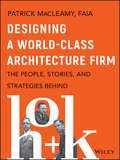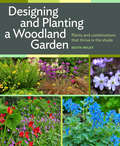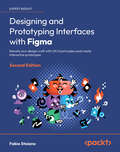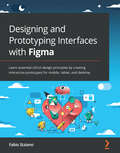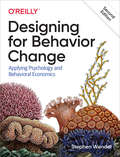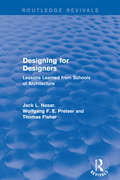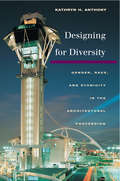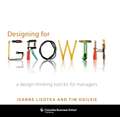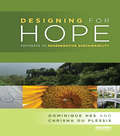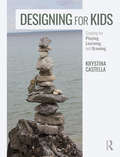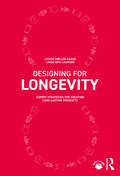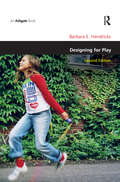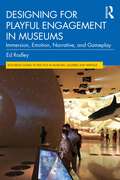- Table View
- List View
Designing Trans-Generational Urban Communities: An Approach towards Inclusive Cities in the Indian Context
by Basudatta Sarkar Haimanti BanerjiThis book examines the inclusiveness of city planning and design to address gaps in policies, strategies and design guidelines for developing trans-generational urban communities in India. Identifying key factors and measurable indicators of trans-generational cities within social, physical, and economic dimensions, the volume highlights the need for establishing age-friendly and child-friendly cities and communities. Through a systematic process of ground data collection, the book explores issues related to health, daily routine, lifestyle, recreation, and socialization within vulnerable groups, considering their physical and cognitive limitations for framing adaptable policies. The volume integrates a bottom-up and top-down approach by integrating the needs and perception of the target group obtained from extensive groundwork with the available theories and literature in allied fields adopting a step-by step synchronized methodology. It also presents the way forward for framing policies focusing on socio-economic security, participation, dignity, care, and self-fulfillment.Offering rich empirical research, this book will be useful for students, teachers and researchers of architecture, urban design, urban geography, urban studies, urban development and planning, and child psychology. It will also be of interest to urban planners and designers, policy planners, local government authorities and professionals engaged in the discipline.
Designing Urban Agriculture
by April PhilipsA comprehensive overview of edible landscapes-complete with more than 300 full-color photos and illustrations Designing Urban Agriculture is about the intersection of ecology, design, and community. Showcasing projects and designers from around the world who are forging new paths to the sustainable city through urban agriculture landscapes, it creates a dialogue on the ways to invite food back into the city and pave a path to healthier communities and environments. This full-color guide begins with a foundation of ecological principles and the idea that the food shed is part of a city's urban systems network. It outlines a design process based on systems thinking and developed for a lifecycle or regenerative-based approach. It also presents strategies, tools, and guidelines that enable informed decisions on planning, designing, budgeting, constructing, maintaining, marketing, and increasing the sustainability of this re-invented cityscape. Case studies demonstrate the environmental, economic, and social value of these landscapes and reveal paths to a greener and healthier urban environment. This unique and indispensable guide: Details how to plan, design, fund, construct, and leverage the sustainability aspects of the edible landscape typology Covers over a dozen typologies including community gardens, urban farms, edible estates, green roofs and vertical walls, edible school yards, seed to table, food landscapes within parks, plazas, streetscapes and green infrastructure systems and more Explains how to design regenerative edible landscapes that benefit both community and ecology and explores the connections between food, policy, and planning that promote viable food shed systems for more resilient communities Examines the integration of management, maintenance, and operations issues Reveals how to create a business model enterprise that addresses a lifecycle approach
Designing Urban Transformation
by Aseem InamWhile designers possess the creative capabilities of shaping cities, their often-singular obsession with form and aesthetics actually reduces their effectiveness as they are at the mercy of more powerful generators of urban form. In response to this paradox, Designing Urban Transformation addresses the incredible potential of urban practice to radically change cities for the better. The book focuses on a powerful question, "What can urbanism be?" by arguing that the most significant transformations occur by fundamentally rethinking concepts, practices, and outcomes. Drawing inspiration from the philosophical movement known as Pragmatism, the book proposes three conceptual shifts for transformative urban practice: (a) beyond material objects: city as flux, (b) beyond intentions: consequences of design, and (c) beyond practice: urbanism as creative political act. Pragmatism encourages us to consider how we can make deeper and more systemic changes and how urbanism itself can be a design strategy for such transformations. To illuminate how these conceptual shifts operate in vastly different contexts through analysis of transformative urban initiatives and projects in Belo Horizonte, Boston, Cairo, Karachi, Los Angeles, New Delhi, and Paris. The book is a rare integration of theory and practice that proposes essential ways of rethinking city-design-and-building processes, while drawing critical lessons from actual examples of such processes.
Designing With Color: Concepts And Applications
by J. R. Watson Chris DoroszThis textbook/workbook trains students' eyes to develop a visual understanding of color and the principles of design through guided observation and engaging activities. Lavishly illustrated with full-color graphics and photos, the book demonstrates how color and other design elements are combined in nature and the visual arts. Part One presents color, the most immediately noticeable element of design. Part Two integrates color with the other design elements and shows how they interact according to the principles of design. Students can apply their learning by completing a series of activities and record their work with photos for future reference.
Designing With Light
by Jason LivingstonA comprehensive introduction to the theory and practice of lighting designDesigning With Light: The Art, Science, and Practice of Architectural Lighting Design is a comprehensive introduction to the intelligent use of lighting to define and enhance a space. The book explores all aspects of the process, including aesthetics, technology, and practicalities, in a clear, concise manner designed to provide the reader with a full working knowledge of lighting design. Color illustrations throughout demonstrate the real-world effects of the concepts presented, and the companion website offers video animations and exercises to better illuminate the art and science of lighting. The book addresses the considerations that should be a part of any designer's process, and provides thorough guidance on meeting the various demands with smarter design.Lighting is an essential element of interior design, and despite its ubiquity, is difficult to truly master. A designer with a fundamental and conceptual understanding of light is empowered to create simple, typical spaces, or work intelligently with lighting consultants on more complex projects. Designing With Light contains special discussions on color, light, and health, as well as the latest information on energy efficient lighting, control systems, and other technologies. Topics include:Physics, psychology, and perception of lightCurrent and future lighting technologyCommunication, documentation, and the design processSustainability, daylighting, and energy efficiencyThe book also contains an entire chapter on building and energy codes, as well as practical guidance on photometrics and calculations. Lighting can make or break an otherwise well-designed space, so designers need the background to be able to think intelligently about illumination factors during all stages of the process. With comprehensive coverage and thorough explanation, Designing With Light is a complete resource for students and professionals alike.
Designing With the Mind in Mind: Simple Guide to Understanding User Interface Design Guidelines
by Jeff JohnsonUser interface (UI) design rules and guidelines, developed by early HCI gurus and recognized throughout the field, were based on cognitive psychology (study of mental processes such as problem solving, memory, and language), and early practitioners were well informed of its tenets. But today practitioners with backgrounds in cognitive psychology are a minority, as user interface designers and developers enter the field from a wide array of disciplines. <p><p>HCI practitioners today have enough experience in UI design that they have been exposed to UI design rules, but it is essential that they understand the psychological basis behind the rules in order to effectively apply them. In Designing with the Mind in Mind, best-selling author Jeff Johnson provides designers with just enough background in perceptual and cognitive psychology that UI design guidelines make intuitive sense rather than being just a list of rules to follow.
Designing Worlds: National Design Histories in an Age of Globalization
by Kjetil Fallan Grace Lees-MaffeiFrom consumer products to architecture to advertising to digital technology, design is an undeniably global phenomenon. Yet despite their professed transnational perspective, historical studies of design have all too often succumbed to a bias toward Western, industrialized nations. This diverse but rigorously curated collection recalibrates our understanding of design history, reassessing regional and national cultures while situating them within an international context. Here, contributors from five continents offer nuanced studies that range from South Africa to the Czech Republic, all the while sensitive to the complexities of local variation and the role of nation-states in identity construction.
Designing Your Dream Home: Every Question to Ask, Every Detail to Consider, and Everything to Know Before You Build or Remodel
by Susan LangYou can have the home of your dreams!This comprehensive guide walks you through every decision and addresses all the details that most homeowners don't even know to consider.In this step-by-step, room-by-room handbook, Susan Lang considers every aspect of your homebuilding or remodeling project, such as how to Hire the right architect, interior designer, and builder Design each room to perfectly fit your family's lifestyle Plan ahead so all your storage needs are met Determine the perfect placement for light fixtures, switches, and electrical outlets Save money by avoiding costly design revisions or building change ordersYou'll find helpful forms and checklists that will keep you organized and assist you in clarifying your needs. And if you're worried that building your dream home might turn into a nightmare, Designing Your Dream Home covers the most common mistakes that homeowners make and shows you how to avoid them. Susan Lang has thought of everything, so you won't have to.
Designing Zero Carbon Buildings Using Dynamic Simulation Methods
by Ljubomir JankovicIn addition to the application of fundamental principles that lead to a structured method for zero carbon design of buildings, this considerably expanded second edition includes new advanced topics on multi-objective optimisation; reverse modelling; reduction of the simulation performance gap; predictive control; nature-inspired emergent simulation leading to sketches that become ‘alive’; and an alternative economics for achieving the sustainability paradigm. The book features student design work from a Master’s programme run by the author, and their design speculation for a human settlement on Mars. Tasks for simple simulation experiments are available for the majority of topics, providing the material for classroom exercise and giving the reader an easy introduction into the field. Extended new case studies of zero carbon buildings are featured in the book, including schemes from Japan, China, Germany, Denmark and the UK, and provide the reader with an enhanced design toolbox to stimulate their own design thinking.
Designing Zero Carbon Buildings: Embodied and Operational Emissions in Achieving True Zero
by Ljubomir JankovicIn this significantly revised third edition, Designing Zero Carbon Buildings combines embodied and operational emissions into a structured approach for achieving zero emissions by a specific year with certainty.Simulation and quantitative methods are introduced in parallel with analogue scale models to demonstrate how things work in buildings. Where equations are provided, this is also explained with common analogue objects, pictures, and narratives. A Zero Equation introduced in this book is not only explained as an equation but also as an analogy with a jam jar and spoons, making the book accessible for a range of audiences. Tasks for simple experiments, exercises, discussion questions, and summaries of design principles are provided in closing lines of chapters.This book introduces new case studies, in addition to an updated case study of the Birmingham Zero Carbon House, applying embodied and operational emissions to assess their status using the Zero Equation. The approach introduced brings about a sense of realism into what true zero emissions mean. Written for students, educators, architects, engineers, modellers, practising designers, sustainability consultants, and others, it is a major positive step towards design thinking that makes achieving zero carbon emissions a reality.
Designing a Place Called Home
by James WentlingThis insightful volume shares design ideas to help builders, planners and architects create mass-produced affordable housing that pushes suburban development in more sustainable, liveable directions. The author argues that improving the quality of design in our new homes and communities for greater resiliency, sustainability, and equality, we can achieve developments that feel more like personalized, individual homes. Through text, photographs and illustrations, the book reviews prototypical American housing design, then suggest ways to both learn from the past as well as adapt for new environmental imperatives, demographic changes and lifestyle needs. Written by a practicing architect with 25+ years of experience optimizing residential design, this pioneering approach to suburban building will inspire readers to view mass produced housing through a new, modern lens.
Designing a World-Class Architecture Firm: The People, Stories, and Strategies Behind HOK
by Patrick MacLeamyOffers architects and creative services professionals exclusive insights and strategies for success from the former CEO of HOK. Designing a World Class Architecture Firm: The People, Stories and Strategies Behind HOK tells the history of one of the largest design firms in the world and draws lessons from it that can help other architects, interior designers, urban planners and creative services professionals grow bigger or better. Former HOK CEO Patrick MacLeamy shares the revolutionary strategies HOK’s founders deployed to create a brand-new type of architecture firm. He pulls no punches, revealing the triple crisis that almost bankrupted HOK and describes how any firm can survive and thrive. Designing a World Class Architecture Firm tells the inside story of many of HOK’s most iconic buildings, including the National Air and Space Museum, Moscone Convention Center, Oriole Park at Camden Yards, the Houston Galleria and the reimagined LaGuardia Airport. Each chapter conveys lessons learned from HOK’s successes —and failures— including: The importance of diversifying to depression-and-recession-proof your firm The benefit of organizing your firm around specialized leaders and project types The difference between leading and managing your people The value of simple financial metrics to ensure your firm’s health and profitability The “run toward trouble” strategy which prevents problems from ballooning MacLeamy delivers his advice via inspirational stories such as how HOK survived when its home office in St. Louis went up in flames and humorous stories, like the time an HOK executive was mistaken for royalty on a trip to Saudi Arabia. In this tell-all guide, the driven architecture or design professional will find the tools needed to evolve or grow any firm.
Designing and Planting a Woodland Garden: Plants and Combinations that Thrive in the Shade
by Keith WileyFrom the creator of "one of the most exciting and innovative gardens in Britain today" With their moss-covered stones, towering trees, and pockets of quiet shade, woodlands have a romantic power unlike anything else. Whether your garden is currently open and sunny, or on the small side, you can capture that sylvan atmosphere with carefully chosen trees and shade-loving plants. In Designing and Planting the Woodland Garden, Keith Wiley explains how to combine plants in natural, self-supporting colonies. His hand-picked selection of unexpected collectables—shrubs, perennials, bulbs, ferns, and grasses—mingle with garden favorites to create fabulous effects in all seasons.
Designing and Prototyping Interfaces with Figma: Elevate your design craft with UX/UI principles and create interactive prototypes
by Fabio StaianoExplore the latest Figma features with this newly updated 2nd edition, including Variables and Conditional Prototyping. Learn cutting-edge design principles and create captivating interfaces with this full-color guide.Key FeaturesExplore Figma's latest features, including Variables and Conditional Prototyping, to create dynamic and responsive interfacesIntegrate AI capabilities and optimize your workflow with the latest Figma pluginsCreate engaging, interactive prototypes that captivate your users and stakeholdersPurchase of the print or Kindle book includes a free PDF eBookBook DescriptionAre you a UI/UX designer eager to learn the art of creating compelling interfaces using Figma? Look no further! The highly anticipated new edition is here to transform your creative journey. Explore Figma's latest features and delve into the power of variables and conditional Prototyping. Get ready to transform your static designs into dynamic, interactive prototypes, offering users and stakeholders an immersive experience. Stay at the forefront of design innovation with insights into integrating AI capabilities and optimizing your workflow with the latest Figma plugins. With user-centric design at its core, this book guides you through mastering design thinking, enabling you to tackle complex design challenges with ease. One unique aspect of this edition is its focus on effective communication. Learn how to convey your design vision clearly to both technical and non-technical audiences. In the rapidly changing world of UI/UX design, iteration is key. This book will teach you how to gather user feedback and iterate on your designs by creating interactive prototypes. Whether you're new to Figma or a seasoned pro, this comprehensive guide equips you with the skills to create captivating interfaces, fosters creativity and problem-solving, and makes you an indispensable, forward-thinking designer.What you will learnCreate high-quality designs that cater to your users' needs, providing an outstanding experienceMastering mobile-first design and responsive design conceptsIntegrate AI capabilities into your design workflow to boost productivity and explore design innovationCraft immersive prototypes with conditional prototyping and variablesCommunicate effectively to technical and non-technical audiencesDevelop creative solutions for complex design challengesGather and apply user feedback through interactive prototypesWho this book is forThis book is for aspiring UX/UI designers who want to get started with Figma as well as established designers who want to migrate to Figma from other design tools. This guide will provide you a walkthrough of the entire process of creating a full-fledged prototype for a responsive interface using all the tools and features that Figma has to offer. As a result, this book is suitable for both UX and UI designers, product and graphic designers, as well as anyone who wants to explore the complete design process from scratch.
Designing and Prototyping Interfaces with Figma: Learn essential UX/UI design principles by creating interactive prototypes for mobile, tablet, and desktop
by Fabio StaianoDiscover user experience and user interface design best practices while mastering a wide array of tools across Figma and FigJam with this full-color guideKey FeaturesLearn the basics of user experience research, result organization, and analysis in FigJamCreate mockups, interactive animations, and high-fidelity prototypes using this platform-independent web application toolCollaborate with a team in real-time and create, share, and test your designsBook DescriptionA driving force of the design tools market, Figma makes it easy to work with classic design features while enabling unique innovations and opening up real-time collaboration possibilities. It comes as no surprise that many designers decide to switch from other tools to Figma.In this book, you'll be challenged to design a user interface for a responsive mobile application having researched and understood user needs. You'll become well-versed with the process in a step-by-step manner by exploring the theory first and gradually moving on to practice. You'll begin your learning journey by covering the basics of user experience research with FigJam and the process of creating a complete design using Figma tools such as Components, Variants, Auto Layout, and much more. You'll also learn how to prototype your design and explore the potential of community resources such as templates and plugins.By the end of this Figma book, you'll have a solid understanding of the user interface workflow, managing essential Figma tools, and organizing your workflow.What you will learnExplore FigJam and how to use it to collect data in the research phaseWireframe the future interface with shape tools and vectorsDefine grids, typography, colors, and effect styles that can be reused in your workGet to grips with Auto Layout and the constraints to create complex layoutsCreate flexible components using styles and variantsMake your user interface interactive with prototyping and smart animateShare your work with others by exporting assets and preparing development resourcesDiscover templates and plugins from the communityWho this book is forThis book is for aspiring UX/UI designers who want to get started with Figma as well as established designers who want to migrate to Figma from other design tools. This guide will take you through the entire process of creating a full-fledged prototype for a responsive interface using all the tools and features that Figma has to offer. As a result, this Figma design book is suitable for both UX and UI designers, product and graphic designers, and anyone who wants to explore the complete design process from scratch.
Designing for Autism Spectrum Disorders
by Angela Bourne Michelle Pearson Kristi Gaines Mesha KleibrinkWinner of the 2017 IDEC Book Award, 2017 EDRA Great Places Award (Book Category), 2017 American Society of Interior Designers Joel Polsky Prize and the 2016 International Interior Design Association TXOK Research Award Designing for Autism Spectrum Disorders explains the influence of the natural and man-made environment on individuals with autism spectrum disorders (ASD) and other forms of intellectual/developmental disabilities (IDD). Drawing on the latest research in the fields of environmental psychology and education, the authors show you how architecture and interior spaces can positively influence individuals with neurodiversities by modifying factors such as color, lighting, space organization, textures, acoustics, and ventilation. Now you can design homes, therapeutic environments, work environments, and outdoor spaces to encourage growth and learning for the projected 500,000 children with ASD (in the United States alone) who are expected to reach adulthood by 2024. Topics discussed include:-Environmental design theories-Symptoms of ASD-Sensory processing deficits -Design needs of individuals on the spectrum at all ages-Design methods and solutions for spaces, including residential, learning, work, and therapeutic environments encompassing a wide range of budgets-Designing for self-actualization, well-being, and a high quality of life for the duration of an individual's life-Avenues for healthy living and aging in place-Biophilic design-Environmental impact on well-being -Strategies to promote active living as an integral part of the welfare focus.
Designing for Behavior Change: Applying Psychology and Behavioral Economics
by Stephen WendelDesigners and managers hope their products become essential for users—integrated into their lives like Instagram, Lyft, and others have become. Such deep integration isn’t accidental: it’s a process of careful design and iterative learning, especially for technology companies. This guide shows you how to apply behavioral science—research that supports many products—to help your users achieve their goals using your product.In this updated edition, Stephen Wendel, head of behavioral science at Morningstar, takes you step-by-step through the process of incorporating behavioral science into product design and development. Product managers, UX and interaction designers, and data analysts will learn a simple and effective approach for identifying target users and behaviors, building the product, and gauging its effectiveness.Learn the three main strategies to help people change behaviorIdentify behaviors your target audience seeks to change—and obstacles that stand in their wayDevelop effective designs that are enjoyable to useMeasure your product’s impact and learn ways to improve itCombine behavioral science with data science to pinpoint problems and test potential solutions
Designing for Designers: Lessons Learned from Schools of Architecture (Routledge Revivals)
by Thomas Fisher Wolfgang F. Preiser Jack NasarFirst published in 2007, this book examines the designs of seventeen architecture and design schools and answers questions such as: How has architectural education evolved and what is its future? Are architectural schools discernible types of designs and what are their effects on those who experience them? What lessons can be learned from evaluations of recently completed school buildings and what guidance do they provide for the design of future ones? Included in the multiple approaches to evaluation are examinations of the history of architectural education and building form; typologies of school for architecture; and the systematic user evaluations of the aesthetics, function, and technology which reveal the strengths to encourage and weaknesses to avoid in future designs. While offering specific guidelines for schools of design, it also includes findings that extend beyond the walls of design schools and can be applied to everything from the interiors of educational and campus buildings to planning offices and gathering places to build communities. This book will make readers more aware of problems in architectural interiors and suggest ways to make interiors work better for the building occupants.
Designing for Diversity: Gender, Race, and Ethnicity in the Architectural Profession
by Kathryn H. AnthonyProviding hard data for trends that many perceive only vaguely and some deny altogether, Designing for Diversity reveals a profession rife with gender and racial discrimination and examines the aspects of architectural practice that hinder or support the full participation of women and persons of color. Drawing on interviews and surveys of hundreds of architects, Kathryn H. Anthony outlines some of the forms of discrimination that recur most frequently in architecture: being offered added responsibility without a commensurate rise in position, salary, or credit; not being allowed to engage in client contact, field experience, or construction supervision; and being confined to certain kinds of positions, typically interior design for women, government work for African Americans, and computer-aided design for Asian American architects. Anthony discusses the profession's attitude toward flexible schedules, part-time contracts, and the demands of family and identifies strategies that have helped underrepresented individuals advance in the profession, especially establishing a strong relationship with a mentor. She also observes a strong tendency for underrepresented architects to leave mainstream practice, either establishing their own firms, going into government or corporate work, or abandoning the field altogether. Given the traditional mismatch between diverse consumers and predominantly white male producers of the built environment, plus the shifting population balance toward communities of color, Anthony contends that the architectural profession staves off true diversity at its own peril. Designing for Diversity argues convincingly that improving the climate for nontraditional architects will do much to strengthen architecture as a profession. Practicing architects, managers of firms, and educators will learn how to create conditions more welcoming to a diversity of users as well as designers of the built environment.
Designing for Growth: A Design Thinking Tool Kit for Managers (Columbia Business School Publishing Ser.)
by Jeanne Liedtka Tim OgilvieJeanne Liedtka and Tim Ogilvie educate readers in one of the hottest trends in business: "design thinking," or the ability to turn abstract ideas into practical applications for maximal business growth. Liedtka and Ogilvie cover the mind-set, techniques, and vocabulary of design thinking, unpack the mysterious connection between design and growth, and teach managers in a straightforward way how to exploit design's exciting potential. Exemplified by Apple and the success of its elegant products and cultivated by high-profile design firms such as IDEO, design thinking unlocks creative right-brain capabilities to solve a range of problems. This approach has become a necessary component of successful business practice, helping managers turn abstract concepts into everyday tools that grow business while minimizing risk.
Designing for Hope: Pathways to Regenerative Sustainability
by Dominique Hes Chrisna du PlessisA forward looking book on sustainable design that describes problems and then, by providing a different way to conceptualise design and development, leads on to examples of regenerative solutions. Its aim is to move the discussion away from doing less, but still detracting from our ecological capital, to positively contributing and adding to this capital. This book offers a hopeful response to the often frightening changes and challenges we face; arguing that we can actively create a positive and abundant future through mindful, contributive engagement that is rooted in a living systems based worldview. Concepts and practices such as Regenerative Development, Biophilic Design, Biomimicry, Permaculture and Positive Development are explored through interviews and case studies from the built environment to try and answer questions such as: ‘How can projects focus on creating a positive ecological footprint and contribute to community?’; How can we as practitioners restore and enrich the relationships in our projects?; and ‘How does design focus hope and create a positive legacy?’
Designing for Kids: Creating for Playing, Learning, and Growing
by Krystina CastellaDesigners, especially design students, rarely have access to children or their worlds when creating products, images, experiences and environments for them. Therefore, fine distinctions between age transitions and the day-to-day experiences of children are often overlooked. Designing for Kids brings together all a designer needs to know about developmental stages, play patterns, age transitions, playtesting, safety standards, materials and the daily lives of kids, providing a primer on the differences in designing for kids versus designing for adults. Research and interviews with designers, social scientists and industry experts are included, highlighting theories and terms used in the fields of design, developmental psychology, sociology, cultural anthropology and education. This textbook includes more than 150 color images, helpful discussion questions and clearly formatted chapters, making it relevant to a wide range of readers. It is a useful tool for students in industrial design, interaction design, environmental design and graphic design with children as the main audience for their creations.
Designing for Longevity: Expert Strategies for Creating Long-Lasting Products
by Louise Møller Haase Linda Nhu LaursenProduct longevity is one of the cornerstones in the transition towards a more sustainable society and a key driver for the circular economy model. This book provides designers, developers, and creators with five distinctive expert strategies, detailed case studies, action guides and worksheets that support both beginning and advanced design practitioners in creating new product concepts with long-lasting strategic fits. Designing for Longevity shows how expert design teams create original and long-lasting product concepts from the early development phase. It focuses on integrating business knowledge, market conditions, company capabilities, technical possibilities and user needs into product concepts to make better strategic decisions. It demonstrates how, for products to be durable, designers must create a long-lasting strategic fit for the customer, company, and market. Key case studies of products such as Bang & Olufsen’s A9, LEGO Ninjago and Friends and Coloplasts’ Sensura Mio, among others, offer readers inspiration, guidance and real-world insights from design teams showing how the strategies can be applied in practice. Action guidelines and worksheets encourage broad, analytical problem-solving to identify and think through challenges at the early concept stage. Beautifully designed and illustrated in full colour throughout, this book combines original research and the hands-on tools and strategies that design practitioners need to create useful, sustainable products.
Designing for Play (Design and the Built Environment)
by Barbara E. HendricksArchitects, landscape designers, builders, gardeners and teachers have all at some time been called upon to design a play area. Unfortunately, this diversity has not resulted in a similar diversity of design solutions for this very problematic task. Despite a proliferation of 'how to' books on this subject, playgrounds have remained virtually the same throughout the world since their creation over a century ago. This is not a 'how to' design book. Instead, based on thirty years' experience as a specialist play area designer, Barbara Hendricks details a radically new approach, applying cutting-edge thinking from child development and child psychology to find innovative design solutions, challenging the established notions of play provision. Covering key sociological, public policy, environmental and design issues, this book provides designers with an exploration of and guide to, designing from a 'child's eye' view of the world. Beautifully crafted and copiously illustrated with numerous examples of recently designed playgrounds, this book is not only stimulating and informative, but fun to read and seriously playful in itself. This second edition brings the text up to date from 2001 to 2010 with added discussion about new ideas for play area designs and what has not worked in the past decade.
Designing for Playful Engagement in Museums: Immersion, Emotion, Narrative, and Gameplay (Routledge Guides to Practice in Museums, Galleries and Heritage)
by Ed RodleyDesigning for Playful Engagement in Museums is filled with creative fodder for practitioners who wish to make more memorable and engaging experiences that promote a sense of presence, effectively evoke emotions, tell stories that transport them, and harness visitors’ innate playfulness.Providing readers with a framework for understanding playful engagement, Rodley details four concepts that, when used effectively, can create a new generation of compelling visitor experiences. This book combines research and examples from the cultural and for-profit sectors with new insights from current research in psychology, neuroscience, and human-computer interaction to explore why these concepts are valuable to designers. Reflections from leading practitioners from around the globe and across the experience design spectrum provide unique insights into the current state of practice. This is augmented by examples from the author’s 30-plus years of experience developing visitor experiences in a variety of science, art, and history museums.Designing for Playful Engagement in Museums provides practitioners with a concrete way of thinking about engagement that centers on visitors. This book will be of particular interest to professionals in museums, libraries, and archives, but will also be essential reading for academics and students engaged in the study of museums, heritage, digital humanities, and experience design.
